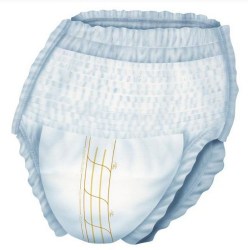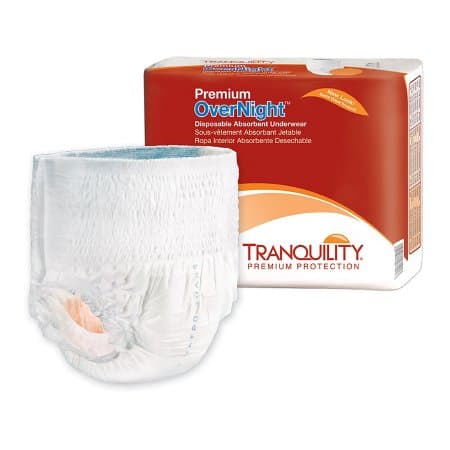An unexpected bladder leak can happen at any time. Incontinence is a bladder control issue that is twice as likely to happen to women than men. Learning what type of incontinence you have is the first step in treating bladder leaks. Then, getting the proper treatment and being prepared with the right incontinence products can help save you from embarrassment and annoyance with the problem.
Two Most Common Types of Incontinence
Stress and urge incontinence are the two most common types that lead to an unexpected bladder leak.
Stress Incontinence
When you experience stress incontinence, coughing, sneezing, or physical exertion triggers an unexpected bladder leak. The leakage can be anywhere from tiny drops to large gushes of urine. There can be many underlying causes of stress incontinence, such as menopause, pelvic surgery, childbirth, or weakened muscles around the bladder.
Urge Incontinence
With urge incontinence, there is a sudden and strong urge to urinate that a person cannot prevent from happening. Most people with urge incontinence have an overactive bladder, which causes their bladder muscles to spasm, leading to an unexpected bladder leak. The uncontrollable bladder muscle contractions make a person feel the urge to urinate.
Identifying and Treating Bladder Leaks
The type of incontinence that leads to an unexpected bladder leak must be identified by a primary care doctor who may refer you to a professional specializing in urinary tract disorders, such as a urologist or gynecologist. Once you know what type of incontinence you have, treatment options are available.
Some of the treatments to strengthen the bladder muscles are:
 Pelvic floor exercises
Pelvic floor exercises
Otherwise known as Kegel exercises, pelvic floor exercises can help strengthen the bladder muscles and urinary sphincter, the small circular muscle that controls when to start and stop urine flow. The layer of muscles that stretch from the tailbone to the pubic bone make up the pelvic floor muscles that support the bladder, bowel, and uterus.
Some of the responsibilities of the pelvic floor muscles are:
- Tightening the sphincter to stop urine flow
- Tightening the anus after a bowel movement
- Pushing urine out of the penis
- Supporting the fetus during pregnancy
To perform Kegel exercises for men and women, follow these steps.
 Lifestyle Changes
Lifestyle Changes
Lose excess weight
If you are overweight, starting an exercise program to lose the extra pounds can be an excellent way to lessen the excess weight put on the bladder.
Fluid consumption
Make sure to drink enough water throughout the day to lessen the risk of dehydration. Avoiding caffeine, alcohol, and carbonated beverages may help improve leakage, too. These kinds of drinks tend to irritate a sensitive bladder.
Quit smoking
And, if you are a smoker, quitting can help with the typical “smoker’s cough,” a chronic cough that puts additional stress on the pelvic muscles that can contribute to an unexpected bladder leak.
Bladder Training
Your healthcare provider may ask you to start a bladder diary to track how frequently you are using the restroom or leaking urine daily. After a few weeks of keeping a bladder diary, you and your doctor can learn more about your daily symptoms.
You can use this bladder diary to attempt to retrain your bladder. If you notice that you are using the restroom every hour, you can try to extend that hour by 10 to 15 minutes longer. You create new benchmarks each time you increase the time between emptying your bladder. The more you practice, the more your symptoms can improve.
Other Options
Other treatment options are available to address bladder leaks if pelvic floor exercises, lifestyle changes, and attempting to retrain your bladder aren’t working out for you.
Medications
Your doctor may prescribe a medication that can help reduce urination urgency and improve your ability to empty your bladder. The Mayo Clinic provides a detailed list of commonly prescribed drugs to treat patients with urinary incontinence and potential side effects.
Botox for overactive bladder
Botox is classified as a neurotoxin, a drug that disrupts the function of the nervous system by destroying nerve tissue. Your doctor typically only discusses this treatment if your incontinence symptoms compromise your overall quality of life.
Learn more about Botox and the possible side effects in our blog, Botox Treatment for Overactive Bladder.
Surgical procedures
If non-surgical treatments for urinary incontinence are unsuccessful or unsuitable, there are surgical procedures your doctor may recommend. Your doctor will discuss these with you if you are a good fit and comfortable moving forward.
Incontinence Products for Bladder Leaks
An unexpected bladder leak doesn’t have to ruin your day or night. Many incontinence products can help you feel comfortable and confident. Whether you regularly participate in outdoor activities, are bound to a wheelchair, have nocturia, or care for someone with incontinence, there are incontinence products available for every need.
Incontinence products like adult briefs and diapers provide complete protection while remaining easy to change without needing to remove all clothing articles. The more modern styles of adult briefs and diapers make them less bulky without compromising absorbency.
Protective underwear is designed to be worn just like regular underwear underneath clothing. These incontinence products are available in various styles, sizes, and absorbencies for both men and women for the protection needed during the day or overnight.
Incontinence products like liners and pads come in a wide range of lengths, thicknesses, and styles to accommodate different body types and lifestyles of men and women. In our blog, All About Incontinence Pads, you can learn more about the difference between the wide range of incontinence liners and pads.
Underpads, bed pads, and chux are some of the most versatile incontinence products. Underpads feature an absorbent zone on the top and can have a cloth-like or plastic, waterproof backing. They have many practical uses around the home, vehicles, and even for potty training pets. Please find all the uses for underpads in our blog, Underpads for Dogs and All Their Uses.
Incontinence clamps for men
Men that experience stress incontinence and have an unexpected bladder leak may benefit from an incontinence clamp. These incontinence products help stop urinary leaks from coughing, sneezing, or straining when lifting things. Incontinence clamps are available in different sizes and are easily removed to empty the bladder.
An unexpected bladder leak shouldn’t control your life. We encourage you to speak to your doctor if you are experiencing a loss of bladder control. Know that there are incontinence products and other options for everyone and that more treatments continuously become available for all types of incontinence. Be your own health advocate when it comes to managing your incontinence. Pay attention to your body, ask questions with your doctor, and educate yourself. You are more likely to get the resources you need when taking an active role in your health care.
For questions or help choosing the incontinence products for your unique needs, our Product Experts are just a phone call away and ready to assist.










